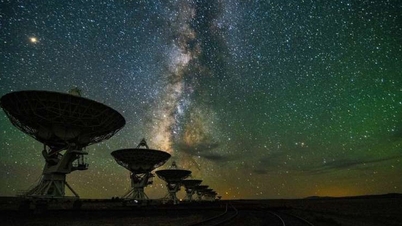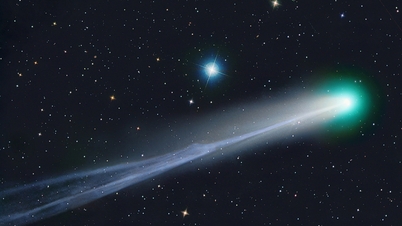
The newly discovered black hole could be the largest black hole ever known (Illustration: Getty).
Astronomers have discovered a giant black hole hidden in a giant galaxy. Its mass is equivalent to 36 billion suns, and it may be the largest black hole ever found. The black hole appeared about 5 billion light years away.
This object, located within the Cosmic Horseshoe star system, 5 billion light-years from Earth, features a phenomenon called gravitational lensing, where light from a distant galaxy is strongly bent by the enormous gravity of the foreground galaxy, creating a near-perfect arc image called the Einstein Belt.
Special detection method
What's special is that this black hole is in a dormant state, not sucking in massive amounts of matter and not emitting strong radiation like active black holes. This makes it harder to detect, because active black holes usually reveal their existence through X-ray radiation from their accretion disks.
To measure the mass, the team combined two methods: observing the gravitational lensing effect and measuring the velocity of stars near the galaxy's center, which move at speeds of up to 400 km/s.
When the two data sources matched, they confirmed that this was a real black hole, possessing enormous gravitational pull.

Map of stars and exoplanets within 25 light-years of the Sun (Photo: Science Alert).
Clues to the evolution of galaxies
According to scientists , the size of a supermassive black hole is often closely related to the size of its parent galaxy.
Specifically, when galaxies merge during evolution, matter is concentrated in the center, feeding the black hole. Some of the energy from active black holes turns into quasars, bright light sources that can heat and stir gas in the galaxy, preventing the formation of new stars.
Notably, the galaxy containing Cosmic Horseshoe is a type of “fossil group”, the end product of a series of galaxy mergers in the past, when companion galaxies disappeared and only a single galaxy remained.
Researchers believe that entire supermassive black holes from companion galaxies merged to create this “cosmic monster.”

There has been no research that allows us to see black holes (Photo: Getty).
Thanks to the gravitational lensing effect, light from the background galaxy is bent around the foreground galaxy containing the black hole, clearly demonstrating the predictions of Albert Einstein's theory of general relativity.
The discovery of Cosmic Horseshoe opens up two important research directions: clarifying the relationship between galaxy size and black hole mass, and understanding the process that makes a black hole so massive.
From an astronomical perspective, this is a rare opportunity to observe the final stages of galaxy formation and black hole evolution in the universe.
Source: https://dantri.com.vn/khoa-hoc/ho-den-bi-an-nang-gap-36-ty-lan-mat-troi-20250808074005774.htm







![[Photo] Prime Minister Pham Minh Chinh receives Lao Minister of Labor and Welfare Phosay Sayasone](https://vphoto.vietnam.vn/thumb/1200x675/vietnam/resource/IMAGE/2025/11/11/1762872028311_dsc-2246-jpg.webp)






























































































![Dong Nai OCOP transition: [Article 3] Linking tourism with OCOP product consumption](https://vphoto.vietnam.vn/thumb/402x226/vietnam/resource/IMAGE/2025/11/10/1762739199309_1324-2740-7_n-162543_981.jpeg)








Comment (0)